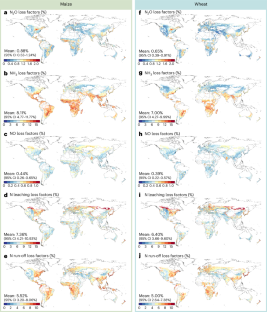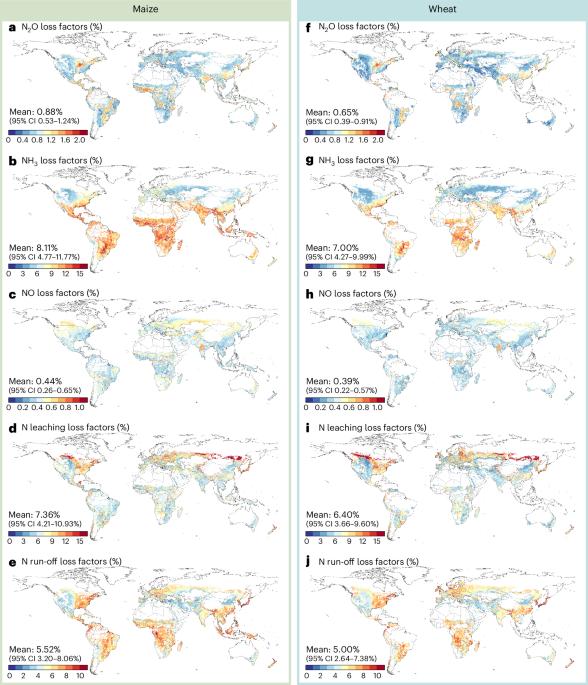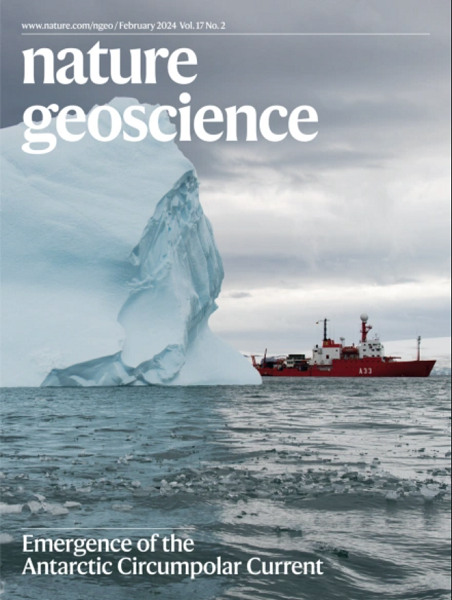减少全球玉米和小麦生产因使用化肥而造成的土壤氮损失
IF 15.7
1区 地球科学
Q1 GEOSCIENCES, MULTIDISCIPLINARY
引用次数: 0
摘要
玉米和小麦是两种主要的主食,共占世界粮食供应的三分之二。这两种作物在种植过程中大量使用氮肥,导致大量活性氮(Nr)流失到环境中。在此,我们利用机器学习算法,根据全球实地测量结果生成了特定作物土壤氮损失的高分辨率地图。我们估计,2020 年全球每年因使用合成氮肥造成的土壤氮损失,包括一氧化二氮 (N2O)、一氧化氮 (NO)、氨 (NH3)、氮浸出和径流的直接排放,玉米分别为 0.18、1.62、0.09、147 和 110 万吨氮,小麦分别为 0.12、1.33、0.07、121 和 95 万吨氮。据估计,玉米和小麦每年因使用合成氮肥造成的这些土壤氮损失而产生的间接一氧化二氮排放量分别为 4.5 万吨和 3.7 万吨,其中水文途径起主要作用。在氮利用率低于这一数值的地区,如果将氮利用率提高到 60%,则这两种作物每年的土壤氮损失总缓解潜力可达 400 万吨,从而将间接一氧化二氮排放量减少 49%。我们的研究结果有助于限制农业化肥使用所产生的全球氮预算,进而有助于利用建模方法改进氮循环-气候反馈的预测。本文章由计算机程序翻译,如有差异,请以英文原文为准。


Reducing soil nitrogen losses from fertilizer use in global maize and wheat production
Maize and wheat are two major staple foods that collectively contribute two-thirds of the world’s grain supply. The extensive use of nitrogen (N) fertilizers during the cultivation of both crops leads to significant losses of reactive nitrogen (Nr) into the environment. Here, using machine learning algorithms, we generate high-resolution maps of crop-specific soil Nr losses based on global field measurements. We estimate that global annual soil Nr losses from the use of synthetic N fertilizer in 2020, including direct emissions of nitrous oxide (N2O), nitric oxide (NO), ammonia (NH3), N leaching and run-off, amount to 0.18, 1.62, 0.09, 1.47 and 1.10 million tonnes N for maize, and 0.12, 1.33, 0.07, 1.21 and 0.95 million tonnes N for wheat, respectively. The annual indirect N2O emissions induced by synthetic N fertilizer use from these soil Nr losses are estimated to be 45,000 and 37,000 tonnes for maize and wheat, respectively, with hydrologic pathways playing a predominant role. Enhancing N use efficiency up to 60% for regions below this value can achieve a total soil Nr loss mitigation potential of 4.00 million tonnes per year for the two crops, thereby reducing indirect N2O emissions by 49%. Our results contribute to constrain global N budgets from the use of fertilizer in agriculture, which then can help to improve projections of nitrogen cycle–climate feedbacks using modelling approaches. Enhancing nitrogen use efficiency can effectively reduce soil nitrogen losses from fertilizer use in the production of maize and wheat, according to a global analysis of field measurement data on crop-specific soil nitrogen losses.
求助全文
通过发布文献求助,成功后即可免费获取论文全文。
去求助
来源期刊

Nature Geoscience
地学-地球科学综合
CiteScore
26.70
自引率
1.60%
发文量
187
审稿时长
3.3 months
期刊介绍:
Nature Geoscience is a monthly interdisciplinary journal that gathers top-tier research spanning Earth Sciences and related fields.
The journal covers all geoscience disciplines, including fieldwork, modeling, and theoretical studies.
Topics include atmospheric science, biogeochemistry, climate science, geobiology, geochemistry, geoinformatics, remote sensing, geology, geomagnetism, paleomagnetism, geomorphology, geophysics, glaciology, hydrology, limnology, mineralogy, oceanography, paleontology, paleoclimatology, paleoceanography, petrology, planetary science, seismology, space physics, tectonics, and volcanology.
Nature Geoscience upholds its commitment to publishing significant, high-quality Earth Sciences research through fair, rapid, and rigorous peer review, overseen by a team of full-time professional editors.
 求助内容:
求助内容: 应助结果提醒方式:
应助结果提醒方式:


